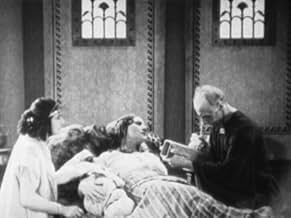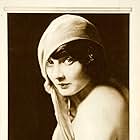In Africa an explorer is the reincarnated lover of the 2,000-year-old White Queen.In Africa an explorer is the reincarnated lover of the 2,000-year-old White Queen.In Africa an explorer is the reincarnated lover of the 2,000-year-old White Queen.
Storyline
Did you know
- TriviaA nitrate copy of this film survives at the UCLA Film and Television Archives.
- ConnectionsVersion of She (1908)
Featured review
This movie only survives in its cut-down version. The is both an advantage for present viewers and a disadvantage. To deal with the latter first, there are a big gaps in continuity, making the story a little difficult to follow for those unacquainted with the novel. The advantages, however, are that with the elimination of the Ustane sub-plot, "She" herself now quickly becomes the center of attention, and deservedly so.
The big question, however, is who plays Vincey (Leo's father) which is now a major role. This scene is directed in quite a different style from the rest of the movie, freely using close-ups of both George and the actor concerned. In the rest of the movie, George has only perhaps four close-ups all told. Tom Reynolds has one. The rest of the players including Blackwell, Blythe and Odette have none at all. (By close-up, I don't mean a shot in which the actor dominates or is photographed alone in the frame, but I mean an actual close-up of the face which fills the screen, TV-style). The actor playing Vincey has at least five or six close-ups in the opening scene, more than Heinrich George in fact, and he (not George) is the principal focus of attention. (George is usually ranked with Emil Jannings and Conrad Veidt as one of the top three German actors in silent films).
I'm going to make a guess here. Maybe I'm wrong, but I think Carlyle Blackwell is playing the role. The director certainly goes out of his way to indulge him, and whoever it is, he puts the sick old man over with plenty of drama. A bit hammy, mind you, but effective nonetheless.
In any case, forty-one-year-old Carlyle Blackwell (who played Bulldog Drummond in 1922 and Sherlock Holmes in 1929) is far too old for the hero, though photographer Blythe does his best to disguise the star's lack of youth (he's supposed to be twenty-five) by keeping his pancaked face (he seems to be wearing a wig) and portly figure (his clothes seem too tight) at a distance. Fortunately, in this version Mary Odette's role has been cut to the bone (a lovely girl indeed but she's an actress of the hair-pulling, eyes popping, mouth wobbling school), allowing us to enter into the presence of Betty Blythe without undue delay. She is by far the sexiest She in the cinema, and no mistake. Her costumes have to be seen to be believed.
Although filmed on a lavish budget, the directors often muff their opportunities. True, there are some fantastic long shots to dazzle the eyes, but 99.9% of the time, the camera is bolted to the floor. The sets cry out for traveling shots to showcase their lavishness, but no such luck. As a general rule, long shots are ineffective on a TV screen, and here we have a couple of directors who are so fond of them, they put the camera at the end of the set all the time, as if they were presenting a stage play or a series of tableaux.
This lack of basic directorial imagination makes the film seem static, old-fashioned, and lacking in movement. When Miss Blythe is not in sight, modern viewers will yawn and fidget and not be at all impressed by the richly decorated sets and often ingenious special effects. In fact most fans will prefer the 1935 or 1965 versions, even though these were filmed on far less extensive budgets from scripts Sir Henry Rider Haggard would definitely not approve. (Haggard gave his imprimatur to this version by writing the titles himself, a task he completed shortly before his death in 1925).
The big question, however, is who plays Vincey (Leo's father) which is now a major role. This scene is directed in quite a different style from the rest of the movie, freely using close-ups of both George and the actor concerned. In the rest of the movie, George has only perhaps four close-ups all told. Tom Reynolds has one. The rest of the players including Blackwell, Blythe and Odette have none at all. (By close-up, I don't mean a shot in which the actor dominates or is photographed alone in the frame, but I mean an actual close-up of the face which fills the screen, TV-style). The actor playing Vincey has at least five or six close-ups in the opening scene, more than Heinrich George in fact, and he (not George) is the principal focus of attention. (George is usually ranked with Emil Jannings and Conrad Veidt as one of the top three German actors in silent films).
I'm going to make a guess here. Maybe I'm wrong, but I think Carlyle Blackwell is playing the role. The director certainly goes out of his way to indulge him, and whoever it is, he puts the sick old man over with plenty of drama. A bit hammy, mind you, but effective nonetheless.
In any case, forty-one-year-old Carlyle Blackwell (who played Bulldog Drummond in 1922 and Sherlock Holmes in 1929) is far too old for the hero, though photographer Blythe does his best to disguise the star's lack of youth (he's supposed to be twenty-five) by keeping his pancaked face (he seems to be wearing a wig) and portly figure (his clothes seem too tight) at a distance. Fortunately, in this version Mary Odette's role has been cut to the bone (a lovely girl indeed but she's an actress of the hair-pulling, eyes popping, mouth wobbling school), allowing us to enter into the presence of Betty Blythe without undue delay. She is by far the sexiest She in the cinema, and no mistake. Her costumes have to be seen to be believed.
Although filmed on a lavish budget, the directors often muff their opportunities. True, there are some fantastic long shots to dazzle the eyes, but 99.9% of the time, the camera is bolted to the floor. The sets cry out for traveling shots to showcase their lavishness, but no such luck. As a general rule, long shots are ineffective on a TV screen, and here we have a couple of directors who are so fond of them, they put the camera at the end of the set all the time, as if they were presenting a stage play or a series of tableaux.
This lack of basic directorial imagination makes the film seem static, old-fashioned, and lacking in movement. When Miss Blythe is not in sight, modern viewers will yawn and fidget and not be at all impressed by the richly decorated sets and often ingenious special effects. In fact most fans will prefer the 1935 or 1965 versions, even though these were filmed on far less extensive budgets from scripts Sir Henry Rider Haggard would definitely not approve. (Haggard gave his imprimatur to this version by writing the titles himself, a task he completed shortly before his death in 1925).
- JohnHowardReid
- Oct 31, 2006
- Permalink
Details
- Runtime1 hour 9 minutes
- Sound mix
- Aspect ratio
- 1.33 : 1
Contribute to this page
Suggest an edit or add missing content



















